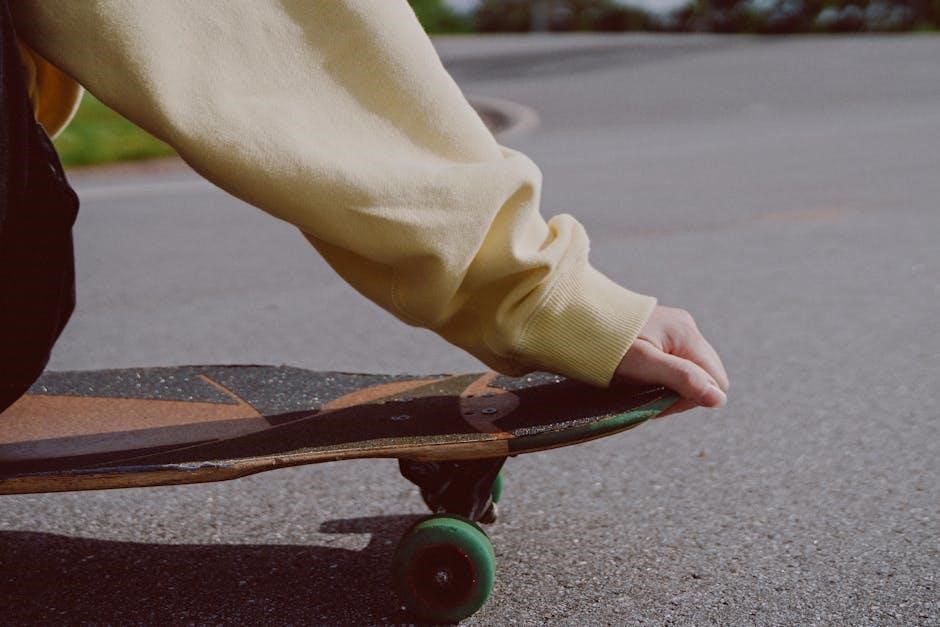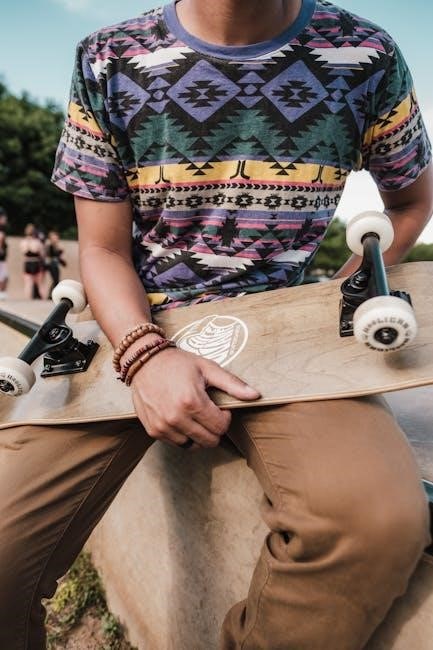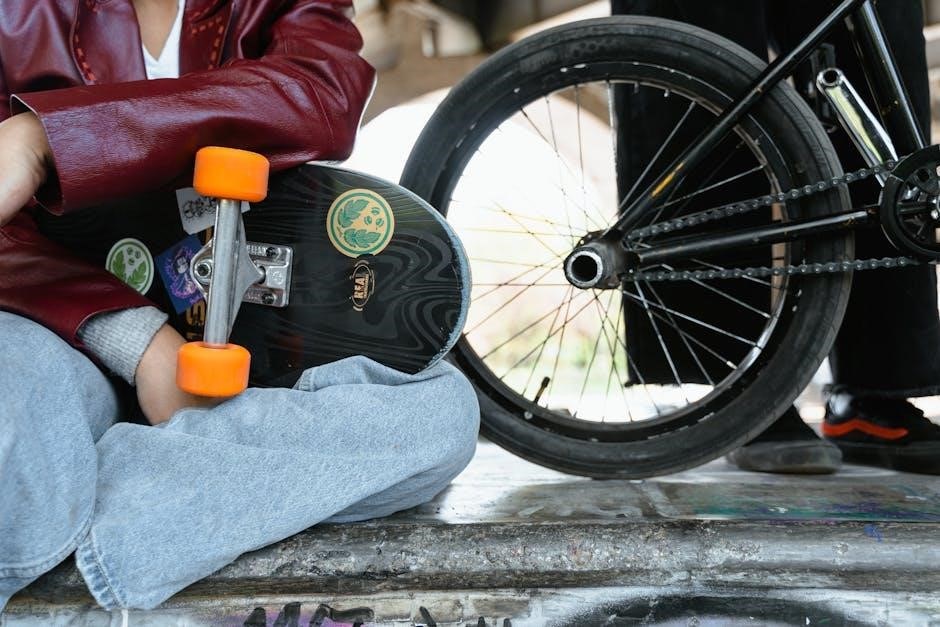Skateboard wheels are a crucial component, impacting performance and style. They come in various sizes, hardness levels, and shapes, each suited for different skating needs and preferences.
Understanding the Importance of Skateboard Wheels
Skateboard wheels are the heart of your setup, directly influencing your riding experience. They determine speed, stability, and how you interact with the ground. The right wheels ensure smooth transitions, better control, and overall performance. Whether cruising, carving, or performing tricks, high-quality wheels provide the necessary grip and durability. Their size, hardness, and shape play a critical role in matching your skating style and terrain. Investing in suitable wheels enhances safety, comfort, and the ability to execute maneuvers effectively, making them an essential component for skaters of all levels.
Key Factors to Consider When Choosing Skateboard Wheels
When selecting skateboard wheels, consider size, hardness, shape, and material. These factors impact speed, grip, and durability, ensuring the best performance for your skating style and terrain.
Wheel Size and Its Impact on Performance
Wheel size significantly affects a skateboard’s performance, with smaller wheels (50-53mm) ideal for street skating and tricks due to their lightweight and agility. Larger wheels (60mm+) suit cruiser and longboard setups, offering speed and stability on rough terrain. The size directly influences acceleration, maneuverability, and comfort, making it essential to choose based on skating style and surface type. Proper fitment ensures optimal performance and safety, avoiding issues like wheel bite. Balancing size with other factors like hardness ensures a tailored ride experience for any skateboarder. Understanding wheel size helps riders optimize their setup for specific skating needs and preferences.

Durometer Ratings: Understanding Wheel Hardness
Durometer ratings measure the hardness of skateboard wheels, typically ranging from 78A to 101A. Softer wheels (78A-87A) offer better grip and cushioning, ideal for cruising and rough surfaces. Harder wheels (95A-101A) provide speed and durability, suitable for street and technical skating. The right durometer ensures optimal performance, balancing grip, speed, and comfort based on skating style and terrain. Proper hardness selection enhances control and safety, while mismatched hardness can lead to poor performance and wear. Understanding durometer ratings helps riders choose wheels that match their needs, ensuring a smooth and responsive skating experience.
Wheel Shape and Profile: How It Affects Your Ride

Wheel shape and profile significantly influence a skateboard’s performance. The shape refers to the wheel’s outline, while the profile determines how it contacts the ground. Rounded wheels offer smooth transitions and are ideal for tricks, requiring less force to flip. Squared or sharp-lipped wheels provide stability at higher speeds, reducing wobble. The profile’s width also plays a role; wider wheels enhance stability but may hinder maneuverability, while narrower wheels allow tighter turns but offer less grip; Choosing the right shape and profile ensures optimal performance, comfort, and control for your skating style, whether cruising, carving, or performing technical tricks.

Types of Skateboard Wheels
Skateboard wheels vary by type, with street wheels being small and hard for tricks, cruiser wheels larger and softer for comfort, and longboard wheels optimized for speed and stability.
Street Wheels: Designed for Tricks and Technical Riding
Street wheels are designed for tricks and technical riding, typically smaller in size (49-55mm) with higher durometer ratings (95A-101A) for durability and responsiveness. Their harder composition provides better grip on rough surfaces while maintaining speed. The narrower profile allows for precise control and easier flipping, making them ideal for street skating. These wheels excel in urban environments, offering the perfect balance of hardness and rebound for technical maneuvers. They are a favorite among skaters who prioritize performance, precision, and durability in demanding setups. Street wheels are essential for mastering tricks and navigating the challenges of street skating with confidence and style.
Cruiser Wheels: Built for Comfort and Smooth Rides
Cruiser wheels are designed for comfort and smooth rides, offering a relaxed skating experience. They are typically larger (56-60mm) and softer (78A-87A durometer) than street wheels, providing excellent grip and shock absorption. The soft polyurethane construction makes them ideal for rough surfaces, reducing vibrations for a smoother ride. Their rounded shape and wider contact patch enhance stability, making them perfect for casual cruising, commuting, or carving. Cruiser wheels are a great choice for skaters who prioritize comfort and ease of use, delivering a laid-back and enjoyable experience on various terrains. They are versatile and suitable for both beginners and experienced riders seeking a relaxed skating style.

Longboard Wheels: Optimized for Speed and Stability
Longboard wheels are specifically designed for speed and stability, making them ideal for commuting, carving, and downhill racing. Typically larger (64-70mm) and slightly harder (77A-87A durometer), they provide exceptional roll speed and durability. Their rounded or square lips ensure smooth transitions and predictable handling, while the wide contact patch enhances grip and stability at high speeds. Constructed from high-quality polyurethane, these wheels are built to withstand rough surfaces and deliver consistent performance. Longboard wheels are a favorite among experienced riders seeking speed, precision, and control for both recreational and competitive skating.
Material and Construction
Skateboard wheels are typically made from high-quality polyurethane, offering durability and a smooth ride. Their construction includes a core that enhances responsiveness, with materials ensuring even wear and longevity.
Polyurethane Wheels: The Standard for Skateboarding
Polyurethane wheels are the most common choice for skateboarding due to their exceptional durability and rebound properties. They provide a smooth ride and are versatile, catering to various skating styles and surfaces. Available in a wide range of hardness levels, polyurethane wheels balance grip and speed, making them suitable for both street and cruiser setups. Their resistance to wear and tear ensures long-lasting performance. The material’s ability to absorb shocks enhances comfort, while its consistent traction supports precise control. Whether for tricks or cruising, polyurethane wheels remain the go-to option for skateboarders worldwide.
Other Materials: Exploring Alternatives and Specialized Options
Beyond polyurethane, alternative materials offer unique benefits for specific skating needs. Ceramic wheels are known for their hardness and speed, often used in competitive racing. Aluminum wheels provide exceptional durability and are favored for their lightweight design, though they can be noisier. Rubber wheels are softer and offer superior grip, making them ideal for rough or uneven surfaces. Composite materials blend different substances for tailored performance, balancing durability and flexibility. These specialized options cater to niche preferences, allowing skaters to customize their setup for optimal results in various environments and skating styles.

How to Choose the Right Wheels for Your Skating Style
Match your wheels to your skating style: softer wheels for cruising, harder for tricks, and larger for speed. Experiment to find your perfect fit.
For Beginners: Wheels That Offer Stability and Control
Beginners should prioritize wheels that offer stability and control. Softer wheels (78A-87A durometer) provide better grip and cushioning, making them easier to balance on. A slightly larger wheel size (54-60mm) enhances stability at lower speeds, while rounded profiles improve maneuverability. Wider wheels also help prevent the board from flipping unexpectedly, giving new skaters confidence. Avoid overly hard or small wheels, as they can make the ride too unforgiving. The right combination of size, hardness, and shape ensures a smoother learning experience, allowing beginners to focus on mastering basic skills without sacrificing fun.
For Advanced Riders: Wheels That Deliver Precision and Speed
Advanced riders seeking precision and speed should opt for harder wheels (95A-101A durometer) with smaller diameters (48-54mm). Harder wheels provide faster roll speed and responsiveness, ideal for technical tricks and smooth transitions. Smaller wheels are lighter, allowing for quicker flips and sharper turns. Look for wheels with rounded or conical shapes for better maneuverability and control. High-rebound polyurethane ensures durability and consistent performance. These wheels excel on smooth surfaces and are tailored for skaters prioritizing speed and precision. They offer the perfect balance of responsiveness and stability for advanced techniques and high-performance skating.
Maintenance and Care
Regularly clean wheels with mild soap and water to remove dirt. Inspect for wear and cracks. Store in a dry place to prevent damage and extend lifespan.
Cleaning and Maintaining Your Skateboard Wheels
Regular maintenance ensures optimal performance and longevity of skateboard wheels. Start by cleaning the wheels with mild soap and warm water to remove dirt and grime. Use a soft brush to scrub the surface and edges, then rinse thoroughly; Inspect for cracks, uneven wear, or damage. Lubricate the bearings periodically to keep them spinning smoothly. Store your board in a dry, cool place to prevent moisture damage. Avoid exposing wheels to extreme temperatures, as this can affect their hardness and performance. Regular cleaning and inspections will help maintain grip, speed, and overall skating experience.
When to Replace Your Wheels: Signs of Wear and Tear
Knowing when to replace skateboard wheels is essential for maintaining performance and safety. Look for signs like uneven wear, cracks, or significant reduction in size. If wheels become misshapen or develop flat spots, they may lose their grip and stability. Additionally, if the wheels no longer spin smoothly or show excessive wear on one side, it’s time for a replacement. Ignoring these signs can lead to poor performance, vibrations, and reduced control. Replace your wheels when they no longer meet your skating needs or show visible damage. Regular inspections can help you identify when it’s time for new wheels.

Common Mistakes to Avoid
Avoid using wheels with incorrect hardness or size for your setup, as this can hinder performance. Neglecting regular maintenance, such as cleaning bearings, can also lead to reduced mobility and damage.
Choosing the Wrong Size or Hardness for Your Setup
One of the most common mistakes skaters make is selecting wheels that are either too large or too small for their board and skating style. Larger wheels offer more speed but may lack maneuverability, while smaller wheels provide precision but can limit speed. Similarly, opting for the wrong durometer rating can significantly impact performance. Softer wheels (lower durometer) offer better grip but wear down faster, while harder wheels (higher durometer) are more durable but less grippy. Choosing the wrong size or hardness can lead to poor performance, reduced control, and increased wear on both the wheels and the board. Always consider your skating style and terrain when selecting wheels to ensure optimal performance and longevity.
Neglecting Maintenance and Upkeep
Neglecting to maintain and upkeep your skateboard wheels can lead to reduced performance and a shorter lifespan. Dirt and debris buildup on the wheels can affect their grip and smoothness, while uneven wear can cause wobbling or instability. Regular cleaning and inspections are essential to ensure optimal functionality. Failing to address worn-out wheels or damaged bearings can result in decreased control and increased risk of damage to the board. Proper care, including cleaning and lubricating bearings, is crucial for maintaining the longevity and performance of your wheels. Neglecting these tasks can lead to safety issues and costly repairs down the line.

Selecting the right skateboard wheels and maintaining them properly ensures optimal performance, safety, and longevity. Regular care and informed choices enhance your skating experience and overall satisfaction.
Final Tips for Selecting and Maintaining Your Skateboard Wheels
When choosing skateboard wheels, prioritize your skating style and terrain. Test different sizes and hardness levels to find your optimal setup. Regularly clean bearings and inspect wheels for wear. Replace wheels when they show significant damage or uneven wear. Stay updated on trends and experiment with new options to enhance performance. Always store your board in a dry, cool place to prevent damage. By combining thoughtful selection and consistent care, you’ll extend the life of your wheels and enjoy a smoother, more enjoyable ride.